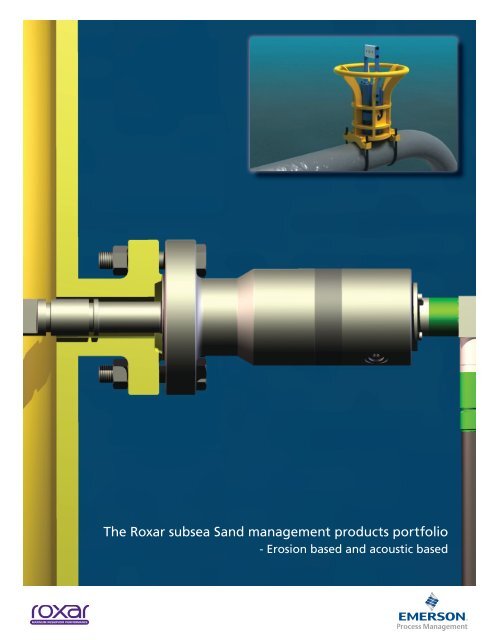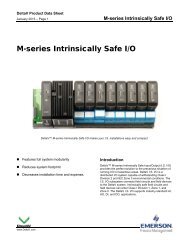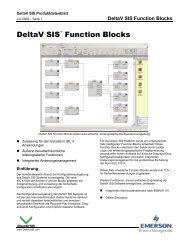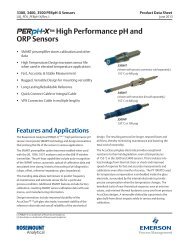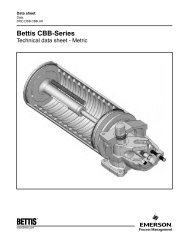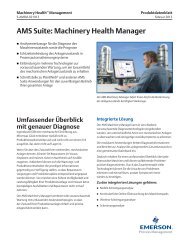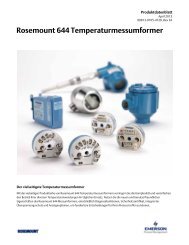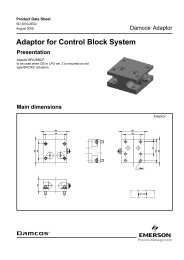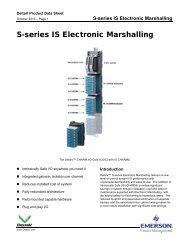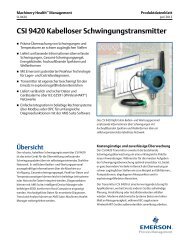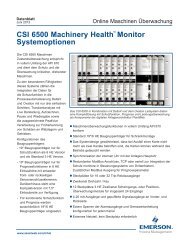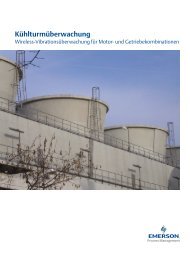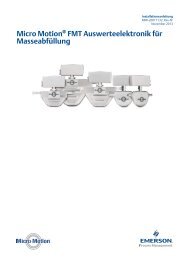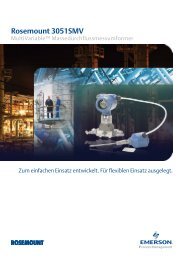Roxar subsea Sand Management Brochure - Emerson Process ...
Roxar subsea Sand Management Brochure - Emerson Process ...
Roxar subsea Sand Management Brochure - Emerson Process ...
You also want an ePaper? Increase the reach of your titles
YUMPU automatically turns print PDFs into web optimized ePapers that Google loves.
The <strong>Roxar</strong> <strong>subsea</strong> <strong>Sand</strong> management products portfolio<br />
- Erosion based and acoustic based
<strong>Roxar</strong> provides two different technologies<br />
for monitoring sand production<br />
- Erosion based and acoustic based.<br />
-----------------------------------------------------------------------------------------------------------------------------------<br />
<strong>Sand</strong> can have a devastating effect on oil and gas production. <strong>Sand</strong> can clog<br />
production equipment and pipelines, erode completion components, impede<br />
wellbore access, interfere with the operation of downhole equipment and even<br />
lead to wells being prematurely shut in or abandoned.<br />
<strong>Management</strong> of sand is therefore critical for maintaining integrity of operator<br />
assets and optimising oil and gas production.<br />
<strong>Roxar</strong> provides two different technologies for monitoring sand production;<br />
erosion based and acoustic based. Erosion based intrusive sensors measure<br />
actual metal loss caused by the impact of sand particles, whereas acoustic based<br />
non-intrusive sensors monitor the noise caused when sand particles impact on<br />
the pipe wall.<br />
<strong>Roxar</strong> <strong>subsea</strong> <strong>Sand</strong> monitor
<strong>Roxar</strong> combined sand<br />
monitoring system<br />
<strong>Roxar</strong> acoustic and erosion based sand monitoring<br />
sensors can be combined to compliment each other<br />
and give the operator the opportunity to have<br />
ultimate control over sand production.<br />
When there is a sand event the operator needs to<br />
take quick decisions to avoid severe damage to their<br />
process system, however at the same time needs to<br />
maintain maximum flow rates.<br />
In <strong>Roxar</strong>’s experience operators feel they cannot<br />
take decisions on changing flow rates purely on the<br />
information from one instrument and hence need a<br />
secondary confirmation before taking a potentially<br />
costly decision. Combining the two systems means<br />
that the operator no longer needs to confirm a sand<br />
event using test separators etc. These two different<br />
state-of-the art sensor technologies can be used to<br />
positively confirm the occurrence and severity of a<br />
sand event, giving the operator confidence that the<br />
correct decision is being made. This builds confidence<br />
in the sand detection devices with the offshore teams<br />
and ensures that the sand management program is<br />
effective, with minimal damage caused and maximum<br />
flow rates achieved.<br />
The acoustic based sensor will provide an<br />
immediate response to the onset of sand production<br />
and rapid response to changes in sand production or<br />
bursts of sand.<br />
The erosion based sensor will also provide a quick<br />
response to the onset or changes to the level of<br />
sand production, although not instantaneous<br />
response due to that fact that it is monitoring actual<br />
damage caused. The erosion based sensor will<br />
accurately determine the short and long term effects<br />
of damage caused by sand. Both systems also quantify<br />
the amount of sand produced when flow velocity<br />
information is provided as an input.<br />
Erosion based, intrusive<br />
sand monitoring<br />
----------------------------------------------------------------------------------------------------------------------------------- -----------------------------------------------------------------------------------------------------------------------------------<br />
<strong>Roxar</strong> <strong>subsea</strong> <strong>Sand</strong> monitor<br />
Erosion based intrusive sand monitoring<br />
probes work on the principle of detecting the<br />
actual damage caused to the metal elements in the<br />
probe when they are impacted by sand particles.<br />
The metal loss is monitored by recording the electrical<br />
resistance of each of the measuring elements on a<br />
regular basis. When metal is lost from these elements,<br />
due to the erosive effects of impacts by sand particles,<br />
the electrical resistance will increase. This increase<br />
in electrical resistance is directly proportional to the<br />
amount of metal that has been lost.<br />
<strong>Roxar</strong> <strong>subsea</strong> SenCorr SE sensor<br />
<strong>Sand</strong> production rates can then be calculated by<br />
combining this measured metal loss with accurate<br />
flow rate information and average sand particle<br />
size. This relationship has been determined through<br />
flow loop testing conducted by <strong>Roxar</strong> and Norsk Hydro.<br />
The <strong>Roxar</strong> sand erosion based sand probes have<br />
multiple elements for redundancy and to cover the<br />
full diameter of the pipe section. The sensor will<br />
measure the sand that impacts it, therefore it is<br />
critical to position the sensor in a location where the<br />
sand is uniformly distributed in the flow typically at<br />
least six ID’s (internal diameter) downstream of a bend.
acoustic based, non-intrusive<br />
sand monitoring<br />
-----------------------------------------------------------------------------------------------------------------------------------<br />
Acoustic based non-intrusive sand monitoring<br />
sensors work on the principle of detecting the sound<br />
created by sand particles when they impact the pipe wall.<br />
The sensor is clamped on to the outside of the pipe,<br />
typically downstream of a 90° bend. The sand particles<br />
that are transported by the process media hit the pipe<br />
wall immediately after the bend due to inertia. These<br />
impacts generate sound and this sound is detected by<br />
the microphone that is mounted on the tip of the sand<br />
monitor. The noise generated is directly proportional<br />
to the velocity and the amount of sand in the process<br />
media. The fact that this device is monitoring sound<br />
means that it will give an immediate response to<br />
changes in sand production.<br />
<strong>Roxar</strong> <strong>subsea</strong> <strong>Sand</strong> monitor<br />
Graph from <strong>Roxar</strong> Fieldwatch showing trending of both the<br />
intrusive sensor (in red) and the 2 acoustic sensors (blue and<br />
green) during a sand trial test.<br />
<strong>Roxar</strong> Fieldwatch - next generation<br />
monitoring software<br />
-----------------------------------------------------------------------------------------------------------------------------------<br />
<strong>Roxar</strong> Fieldwatch is <strong>Roxar</strong>’s integrated software<br />
system suite for easy handling, monitoring,<br />
confi guring and operation of <strong>Roxar</strong> instruments.<br />
<strong>Roxar</strong> Fieldwatch enables a higher level of usability<br />
of <strong>Roxar</strong>’s measurement solutions, and integrates<br />
the different instruments into a common software<br />
system with easy access for operators, production<br />
engineers and <strong>Roxar</strong> service personnel. <strong>Roxar</strong><br />
Fieldwatch can be used locally in the fi eld and also<br />
remotely, enabling better collaboration between the<br />
production team.<br />
<strong>Roxar</strong> Fieldwatch provides state-of-the-art tools<br />
for in-depth analysis and investigation of data sets.<br />
Built in instant chart analysis tools allow easy trend<br />
analysis of different data sets on one plot. In addition<br />
related alarms can be made visible in the plot, thus<br />
ensuring all information is available when concluding<br />
on actions to be taken during a sand event or when<br />
optimising well fl ow rates. This combined with an<br />
extremely fast database ensures a rapid interactive<br />
analysis of a situation and results in well made decisions.<br />
The latest release, <strong>Roxar</strong> Fieldwatch 3, comes with<br />
innovative smart alarm software consisting of new<br />
fi ltering and temperature compensation algorithm.<br />
The result will be a dramatic reduction in the number<br />
of false alarms from erosion probes while retaining all<br />
the genuine alarms. The same smart alarms principle<br />
is being tested on corrosion monitoring as well.<br />
There is also the possibility to have Fieldwatch<br />
virtual erosion module which enables operators to<br />
install virtual erosion sensors within their production<br />
system – particularly to monitor bends, T-bends and<br />
reducers in areas where it’s diffi cult to deploy<br />
physical sensors.
WWW.ROxaR.COM<br />
INFO@ROxaR.COM


